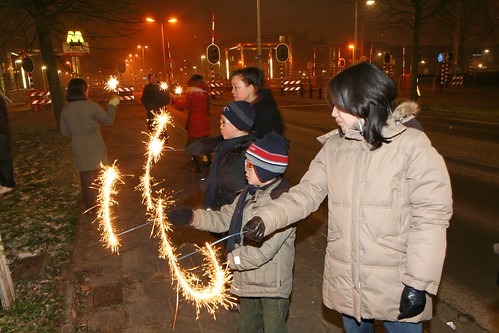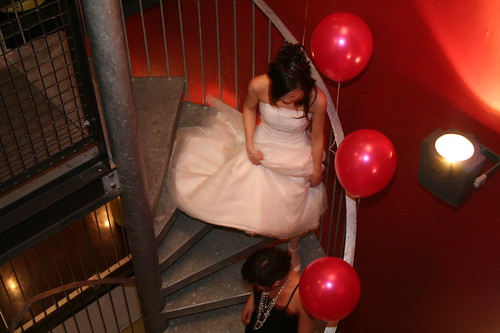
Photo technical details:
Canon 350D | 17-55mm | 3/10 sec @ f/5.6 | ISO 400
Canon 580 EXII straight on flash in E-TTL II mode.
One of the topics of the flash session in our photo course is the effect of synchronizing the flash on the first or second curtain of the camera shutter. In this blog post I want to illustrate when and why to use second curtain sync.
The photo was shot on New Year’s Eve 2008-2009. I wanted to have the following result:
- See the trail of the sparklers which were moved up and down.
- See something of the background.
Avoid the ‘people against a black background’ look.
- Have a ‘natural look’ of the sparkler movement.
In order to get a sparkler trail you need to have a slow shutter speed. With a slow shutter speed the light of the moving sparks is recorded. When you select a shutter speed which is too fast, you will get no trail at all.
In addition I wanted a ‘natural look’. With that I mean the sparkler sticks should be at the end of the trail, not the beginning. So I configured the flash to fire just before the shutter closes (second curtain sync or rear curtain sync). This has the following effect:
- the shutter opens,
- the movement of the sparkler is recorded,
- the flash fires so the people are registered,
- and the shutter closes.
This way the sparkler is at the end of the movement.
The default setting or first curtain sync would have the following effect:
- the shutter opens,
- the flash fires so the people are registered,
- the movement of the sparkler is recorded,
- and the shutter closes.
The sparkler stick would be on the beginning of the spark trail.
So the second curtain sync takes care of having the sparkler in the right position. Now we have to make sure we see something in the background.
I did the following in order to make sure you see the details of the background:
- put the camera in M(anual) mode.
- While aiming at the background, set the exposure to 1 stop below the recommended setting of the camera meter.
- Make sure you have a slow enough shutter speed. In this example I selected 3/10th of a second with an aperture of f/5.6 at ISO 400. Or rather: I selected 3/10 sec. shutter speed and an aperture of f/5.6 and then I adjusted my ISO speed to arrive at the –1 stop exposure for the background.
- Put the flash exposure on Auto (in this case Canon E-TTL II mode).
These settings have the following effect:
- The –1 stop exposure ensures you see the street lights in the background of the photo, and that the background is not too bright.
- The slow shutter speed makes sure you see the movement of the sparklers.
- With an aperture of f/5.6 the foreground and the background of the photo will be sharp.
- The automatic flash exposure mode causes the flash to give enough light to illuminate the foreground correctly. I do not have to set the flash output manually.
So that’s how you can do it! While explaining it takes quite a few words, in the real world I configured my camera within 5 seconds or so. The tricky part is to know what shutter speed, aperture and ISO to choose. I can only say you have to practice a lot and experiment in order to select a good shutter speed. Also you have to learn how to handle your camera and set all the various settings in a dark environment where you do not see all the labels of your buttons!
Remark 1
You should hold your camera very still when shooting the photo because of the low shutter speed. The lens I used is equipped with IS = image stabilization. This means that the lens can compensate for camera shake (within an acceptable range).
Remark 2
Second curtain sync is called differently by each manufacturer. Canon shooters should look under ‘2nd curtain sync’. Nikon shooters should look under ‘rear curtain sync’. It could be that second curtain sync is not possible with your internal flash. Please check your manual.
Remark 3
It is possible to shoot in Av (Canon) or A (Nikon) mode so you select the aperture of f/5.6 and the camera selects a shutter speed. I do not use this mode because I want to be in full control of the shutter speed as well. When I take the shot and the background looks not right, I only have to adjust the shutter speed to obtain the look I want. In Av or A mode I am at the mercy of the camera when I take my next shot.
Remark 4
The most important thing is to have an interesting subject in the photo. My family loves this photo because they know all the people in it. For you it might be a boring picture (Just admire the sparkler trails then :-)








